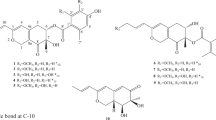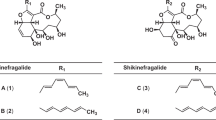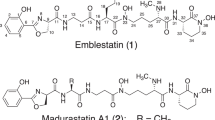Abstract
In the course of our screening program for active compounds from fungal metabolites, we isolated JBIR-12 (1) as a free radical scavenger from the culture broth of Penicillium sp. NBRC 103941. Structure elucidation of 1 was carried out using methylated and/or acetylated derivatives of 1. As a consequence, the structure of 1 was determined to be a novel highly oxygenated tetrahydronaphthalene species attached to an acyl chain moiety on the basis of NMR and other spectroscopic data. It was interesting that 1 was spontaneously methylated when left in methanol. Furthermore, isomerization or rearrangements could occur during the derivatization of 1. Compound 1 exhibited potent radical scavenging activity against 1,1-diphenyl-2-picrylhydrazyl radical with an IC50 value of 75 μM.
Similar content being viewed by others
Introduction
Free radicals play a causative role in many disease states including atherosclerosis, inflammation, ischemia-reperfusion injury, rheumatism and central nervous diseases.1 In addition, senility and cancer initiation as well as progression are also believed to involve active oxygen species.2 In fields of such diseases, an effective antioxidant could be a useful lead compound for the development of a clinically useful drug. Historically, Penicillium species have been shown to be producers, with more than 900 bioactive compounds documented.3 Furthermore, the important pharmaceutical agents, penicillin (antibiotic) and compactin (lipid-lowering agent), were isolated from Penicillium spp. Therefore, we carried out the screening for antioxidants from culture broths of Penicillium species.
In the course of our screening program from metabolites of Penicillium spp., we isolated a novel antioxidative agent, designated as JBIR-12 (1), from the culture broth of Penicillium sp. NBRC 103941. The structure of 1 contains highly oxygenated tetrahydronaphthalene moiety possessing an acyl chain, and shows unique chemical features. This paper describes the fermentation, isolation, physico-chemical properties, structure elucidation and biological activity of 1 as well as a hypothetical reaction mechanism of the addition of methanol to 1.
Results and discussion
Isolation
The culture (100-ml Erlenmeyer flask × 20) was extracted with 80% Me2CO (400 ml). The extract was evaporated in vacuo, and the residual aqueous concentrate was extracted with EtOAc (100 ml × 3). After drying over Na2SO4, the organic layer was evaporated to dryness. The dried residue (1.87 g) was chromatographed on normal-phase medium-pressure liquid chromatography (Purif-Pack SI-60; Moritex, Tokyo, Japan) with an n-hexane-EtOAc linear gradient system (0–100% EtOAc), and fractions including major metabolites were collected by LC-MS monitoring. The eluate (70–100% EtOAc, 720 mg) was further separated by a reversed-phase flash column (Purif-Pack ODS-100; Moritex) with an H2O-MeOH linear gradient system (50–100% MeOH) to yield a major fraction (80–100% MeOH, 276 mg). This eluate was subjected to preparative reversed-phase HPLC developed with 60% aqueous MeCN containing 0.2% formic acid (flow rate: 10 ml min−1) to yield 1 (Rt 9.8 min, 26.1 mg).
Structure elucidation
The physico-chemical properties of 1 are summarized in Table 1. Compound 1 was isolated as a red powder and had the molecular formula C24H28O8 revealed by HR-ESI-MS data (m/z 443.1694 (M-H)−, Δ −1.2 mmu). The structure of 1 was established mainly by NMR analyses of 1 and its chemically modified derivative 3 as follows:
The direct connectivity between protons and carbons was established by the HSQC (heteronuclear single-quantum coherence) spectrum, and the tabulated 13C and 1H NMR spectral data for 1 are shown in Table 2. The 1H-1H DQF (double-quantum filtered)-COSY and HMBC (heteronuclear multiple bond correlation) spectra established two partial structures (Figure 1). The combination of proton coupling constants and 1H-1H correlations in the 1H-1H DQF-COSY constructed an acyl chain substructure as shown in Figure 1. The sequence from 2′-H (δH 5.99) to 10′-H (δH 0.88) through 3′-H (δH 7.36), 4′-H (δH 6.37), 5′-H (δH 6.67), 6′-H (δH 6.20), 7′-H (δH 5.88), 8′-H (δH 2.14) and 9′-H (δH 1.37), in addition to a spin coupling between 8′-H and 11′-H (δH 1.03), established the branched alkyl chain moiety. The proton spin coupling constants between 2′-H and 3′-H (J=15.3 Hz), 4′-H and 5′-H (J=14.8 Hz), and 6′-H and 7′-H (J=15.2 Hz), together with the 1H-13C long-range correlations from 2′-H and 3′-H to C-1′ (δC 166.8), revealed a (2E,4E,6E)-8-methyldeca-2,4,6-trienoate moiety as shown in Figure 1a.
Oxygenated methylene protons 13-H (δH 5.08, 4.68), were 1H-13C long-range coupled to C-5 (δC 121.6), C-6 (δC 128.2) and C-7 (δC 146.3). An aromatic proton, 9-H (δH 7.22), was m-coupled to C-5 and C-7 in the HMBC spectrum of 1. Thus, the hydroxymethyl group was deduced to be substituted at the position of C-6. Long-range couplings from 9-H to C-8 (δC 153.1) and C-10 (δC 140.4), together with the 13C chemical shifts at C-7 and C-8, established the assignments of a benzene ring moiety. A methyl proton, 11-H (δH 1.60), was long-range coupled to C-1 (δC 76.2), C-2 (δC 206.7) and C-10. In the same manner, a methyl proton, 12-H (δH 1.54), was long-range coupled to C-2, C-3 (δC 85.5) and C-4 (δC 194.1). In addition, a long-range coupling was observed between the aromatic proton 9-H and C-1, which indicated that C-1 was located at the peri position of 9-H. Thus, highly oxygenated tetrahydronaphthalene moiety was determined as shown in Figure 1b.
To establish the substituted position of the acyl chain moiety of 1, chemical modification was carried out as follows: Treatment of 1 with methyl iodide and potassium carbonate in DMF afforded a (7,8,13)-O-trimethyl-JBIR-12 (2) as a main derivative. Each 1H-13C long-range correlation from methoxyl groups 7-OMe, 8-OMe and 13-OMe to C-7, C-8 and C-13, respectively, deduced substituted position of their methoxyl groups. Only one hydroxyl group at C-1 could not be methylated, and then 2 was acetylated by acetic anhydride in pyridine to give a (7,8,13)-O-trimethyl-1-O-acetyl-JBIR-12 (3). NOEs between 9-H and 11-H, and 9-H and methyl proton at acetyl residue revealed that the acyl chain moiety is substituted at the position of C-3 by an ester bond (Figure 2). Thus, the total structure of 1 was elucidated as shown in Figure 3.
During NMR experiments of 1 in methanol-d4, we observed the appearance of some extra signals corresponding to deuteride methoxyl groups. The LC-MS analyses of this sample indicated that 1 was changed to deuterium labeled mono- or di-O-methyl compounds. Hence, we speculated that this reaction occurred by a subsequent process. The hydroxyl group at C-13 in 1 was first displaced with a methoxyl group in MeOH. Further displacement of the hydroxyl group at C-7 with a methoxyl group gradually occurred. Considering into these results, dehydration at C-13 could be accompanied by 1,4-addition of MeOH or 1,2- and 1,4-addition of MeOH through a hypothetical scheme as shown in Figure 4. Furthermore, 1 might be isomerized or rearranged during a derivatization to 2, as acylation of 2 afforded several minor congeners, of which some methoxyl signals were recognized in its 1H NMR spectrum. Therefore, we could not determine the relative stereochemistry at C-1 and C-3, although an NOE between the methyl proton of the acetyl group and the methyl proton 12-H was observed. This compound seems to keep its structure intact on subtle electron translocation balance. Therefore, 1 is quite an interesting target for total synthesis, which is desired to establish its stereochemistry.
Biosynthetically, 1 is hypothetically produced through the combination of two different pathways. We speculated that (2E,4E,6E)-8-methyldeca-2,4,6-trienoate moiety is biosynthesized by type-I polyketide synthase, and an oxygenated tetrahydronaphthalene moiety comes from a fungal 1,8-dihydronaphthalene (DHN)-melanin pathway.4, 5 The highly oxygenated and methylated tetrahydronaphthalene moiety and (2E,4E,6E)-8-methyldeca-2,4,6-trienoate moiety are connected through an ester bond. Studies on detailed biosynthetic pathway require further labeling and genetic experiments.
Biological activity
We evaluated 1,1-diphenyl-2-picrylhydrazyl (DPPH) radical scavenging activity by 1. Compound 1 exhibited DPPH radical scavenging activity with an IC50 value of 75 μM, which was almost the same activity as that of α-tocopherol (IC50=50 μM). The structure of 1 involves phenolic hydroxyl groups, which are considered to play a significant role in expressing radical scavenging activity. Actually, the derivatives 2 and 3 did not show any radical scavenging activity at the concentration of 200 μM. Studies on detailed biological activities are now underway.
Methods
General experimental procedures
Melting point was determined with a Yanagimoto micro melting point apparatus (Yanagimoto, Kyoto, Japan). Optical rotations were operated on a SEPA-300 polarimeter (Horiba, Kyoto, Japan). HR-ESI (electrospray ionization)-MS data were recorded on an LCT-Premier XE mass spectrometer (Waters, Milford, MA, USA). UV and IR spectra were measured on a U-3200 spectrophotometer (Hitachi, Tokyo, Japan) and an FT-720 spectrophotometer (Horiba), respectively. NMR spectra were recorded on an NMR System 600 or 500 NB CL (Varian, Palo Alto, CA, USA). Chemical shifts are reported in p.p.m. relative to chloroform (7.26 p.p.m. for 1H) or chloroform-d (77.0 p.p.m. for 13C), and methanol (3.30 p.p.m. for 1H) or methanol-d4 (49.0 p.p.m. for 13C). Normal- and reversed-phase medium-pressure liquid chromatography was performed on a Purif-Pack SI-60 (Moritex) and a Purif-Pack ODS-100 (Moritex), respectively. Preparative reversed-phase HPLC was carried out on a Senshu Pak PEGASIL ODS (20 i.d. × 150 mm; Senshu Scientific, Tokyo, Japan) with detection by a 2996 photodiode array detector (Waters) and a 3100 mass detector (Waters). Reagents and solvents were of the highest grade available.
Microorganism
Penicillium sp. NBRC 103941 was purchased from the National Institute of Technology and Evaluation (NITE; Tokyo, Japan).
Medium and fermentation
The seed medium, potato dextrose, was composed of 2.4 g l−1 Potato Dextrose Broth (BD Biosciences, San Jose, CA, USA). The production medium consisted of 3 g of brown rice (Hitomebore, Miyagi, Japan), 6 mg of Bacto-Yeast extract (BD Biosciences), 3 mg of sodium tartrate, 3 mg KH2PO4 and 9 ml of H2O in a 100-ml Erlenmeyer flask.
Penicillium sp. NBRC 103941 was cultivated in 50-ml test tubes containing 15 ml of a seed medium. The test tubes were shaken on a reciprocal shaker (355 r.p.m.) at 27 °C for 3 days. Aliquots (5 ml) of the culture were transferred to 100-ml Erlenmeyer flasks containing the production medium and incubated in static culture at 27 °C for 14 days.
Methylation and acetylation
Compound 1 (1.1 mg) was dissolved in 250 μl of DMF, mixed with 0.2 mg of K2CO3 and 25 μl of methyl iodide and stirred at room temperature overnight. The mixture was diluted with MeOH, evaporated in vacuo and applied to preparative reversed-phase HPLC using a PEGASIL-ODS (Senshu Pak, 20 i.d. × 150 mm) developed with 80% aqueous MeOH containing 0.1% formic acid (flow rate: 10 ml min−1) to give (7,8,13)-O-trimethyl JBIR-12 (2, Rt 13.0 min, 0.5 mg). The structure of 2 was confirmed by LC-MS and NMR analyses.
Compound 2 (0.5 mg) was dissolved in 200 μl of pyridine, mixed with 20 μl of acetic anhydride and stirred at room temperature overnight. The mixture was diluted with H2O, extracted with EtOAc and the organic extract was evaporated in vacuo. This extract was applied to preparative reversed-phase HPLC (Senshu Pak PEGASIL-ODS, 20 i.d. × 150 mm) developed with 85% aqueous MeOH containing 0.075% formic acid (flow rate: 10 ml min−1) to yield (7,8,13)-O-trimethyl-1-O-acetyl-JBIR-12 (3, Rt 11.5 min, 0.4 mg, C29H36O9, m/z 529.2438 (M+H)+, Δ 0 mmu). The structure of 3 was established by NMR analyses (Table 2).
DPPH radical scavenging activity
A 96-well multiplate was used for the DPPH radical scavenging assay.6 Compound 1 and α-tocopherol as a positive control were dissolved in MeOH to prepare samples of 1 mM, before being diluted with MeOH to prepare samples of a linear concentration system of 0.01–0.5 mM. A volume of 90 μl of 200 μM DPPH dissolved in MeOH and 10 μl of sample were mixed in the microplate. After 1 h incubation at room temperature, the absorbance was measured at 540 nm.
References
Hammond, B., Kontos, A. & Hess, M. L. Oxygen radicals in the adult respiratory distress syndrome, in myocardial ischemia and reperfusion injury, and in cerebral vascular damage. Can. J. Physiol. Pharmacol. 63, 173–187 (1985).
Finkel, T. Radical medicine: treating ageing to cure disease. Nat. Rev. Mol. Cell Biol. 6, 971–976 (2005).
Bérdy, J. Bioactive microbial metabolites. J. Antibiot. 58, 1–26 (2005).
Wheeler, M. H. & Bell, A. A. Melanins and their importance in pathogenic fungi. In Current Topics in Medical Mycology Vol. 2. (ed. McGinnis, M.R.) 338–387 (Springer-Verlag, New York, NY, 1988).
Tsai, H. F., Wheeler, M. H., Chang, Y. C. & Kwon-Chung, K. J. A developmentally regulated gene cluster involved in conidial pigment biosynthesis in Aspergillus fumigatus. J. Bacteriol. 181, 6469–6477 (1999).
Wang, G. J., Lin, S. Y., Wu, W. C. & Hou, W. C. DPPH radical scavenging and semicarbazide-sensitive amine oxidase inhibitory and cytotoxic activities of Taiwanofungus camphoratus (Chang-chih). Biosci. Biotechnol. Biochem. 71, 1873–1878 (2007).
Acknowledgements
This work was supported by a grant from the New Energy and Industrial Technology Department Organization (NEDO) of Japan.
Author information
Authors and Affiliations
Corresponding authors
Rights and permissions
About this article
Cite this article
Izumikawa, M., Nagai, A., Doi, T. et al. JBIR-12, a novel antioxidative agent from Penicillium sp. NBRC 103941. J Antibiot 62, 177–180 (2009). https://doi.org/10.1038/ja.2009.13
Received:
Revised:
Accepted:
Published:
Issue Date:
DOI: https://doi.org/10.1038/ja.2009.13
Keywords
This article is cited by
-
JBIR-124: a novel antioxidative agent from a marine sponge-derived fungus Penicillium citrinum SpI080624G1f01
The Journal of Antibiotics (2012)
-
JBIR-25, a novel antioxidative agent from Hyphomycetes sp. CR28109
The Journal of Antibiotics (2009)
-
JBIR-54, a new 4-pyridinone derivative isolated from Penicillium daleae Zaleski fE50
The Journal of Antibiotics (2009)







